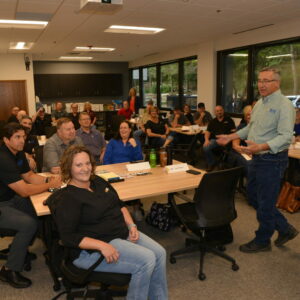Safety training in 2024 is changing, as the way people learn, and learning practices are evolving. This pace underscores the importance of safety leader’s learning the proper ways to teach others. Recent studies indicate that the half-life of a skill is approximately 5 years, meaning the knowledge gained a decade ago may now be largely outdated, and half of what was learned five years ago might no longer be relevant.
For an injury-free workplace, it’s essential to have leaders who can adapt and grow, demonstrating continuous learning by guiding their teams toward safety excellence.
This is why the concepts of learning and leadership are intertwined, especially in the realm of safety leader’s continous learning. Effective safety leadership is rooted in continuous education and development. There’s no final destination in this journey. The more knowledge and skills you acquire, the more proficiently you will lead. Embracing this mindset is the first step towards mastering safety leadership.
Growth Mindset
Research shows that people with a growth mindset are better at dealing with change, solving problems, successfully implementing and giving feedback, and accomplishing goals. They recognize patterns, make better, faster decisions, drive innovation and stay relevant.
Savvy leaders recognize this means investing in their own learning journey, so they can develop the processes and behaviors required for ongoing success. Here are some reinforcing quotes from some of our greatest leadership OGs!
“The best leaders are lifelong learners; they take measures to create organizations that foster and inspire learning throughout.” John Wooden
“Leaders must get comfortable with living in a state of continually becoming, a perpetual beta mode.” Kenneth Mikkelsen and Harold Jarche, Harvard Business Review.
“Anyone who stops learning is old, whether at 20 or 80. Anyone who keeps learning stays young. The greatest thing in life is to keep your mind young.” Henry Ford
“Just because you are on the leadership team, don’t think you have ‘landed.’ You must continually increase your learning, the way you think, and the way you approach the organization.” Indra Nooyi, former CEO of PepsiCo
10 Ways to Continually Learn
Here are some ideas on how to fit learning into a busy schedule and become a self-directed, autonomous learner.
- Have a growth mindset. This is an attitude that we can all improve our skills, abilities and emotional intelligence. In fact, the science of neuroplasticity shows that the brain can reorganize pathways, create new connections and even change how its circuits are wired – with time, effort and energy!
- Ask yourself 3 questions. 1) “What can I learn?” 2) “What should I learn?” 3) “What do I want to learn?”
- Find your best way of learning. Think about how you prefer to learn. Whether podcasts or reading books and articles, discover what works best for you.
- Try new ways of learning. If you only stay in your comfort zone, you won’t have exposure to new experiences that could help you grow and develop.
- Learn from mistakes. The best leaders learn from experiences, including failures – and apply those lessons to unfamiliar situations in the future. Think about some of your greatest failures and what you learned from it. Practice turning challenges into opportunities rather than threats.
- Practice active listening. Listen and learn from others, whether colleagues, customers, family members or friends. Find new ways to apply the information. In his book, “What Got You Here Won’t Get You There,” executive coach, Marshall Goldsmith states: “80% of our success in learning from other people is based on how well we listen!”
- Take Clarity Breaks. Because the normal course of day-to-day business activity can pull you deeper and deeper into the minutiae, stay sharp, confident and at your best for your people by taking time on a regular basis for a “clarity break.” Schedule a regular appointment with yourself, off-site preferably, to work “on” the business, rising above the everyday demands of the job and think at the 30-thousand-foot level.
- Consider digital tools. Since the pandemic, digital tools are revolutionizing the way we learn. With so many online learning tools available, there is no excuse not to continue your learning. See https://www.hurix.com/best-digital-learning-tools/
- Share your knowledge. Exchange resources, ideas and experiences with your network. Write an article for your trade journal, post a blog on your company’s website, arrange a webinar or give a speech at an industry event. While sharing knowledge will help reinforce learning, it will also position you as a thought leader and build your reputation and trust.
- Invest in your team. Great leaders invest in their team development the same way that they invest in themselves. Learning becomes part of the organization’s DNA, creating strong motivated teams and fostering a culture where everyone is empowered to reach their full potential.
Commitment to life-long learning is the mark of great leadership, ensuring the future success of an organization. It keeps us relevant. And if we instill a culture of learning, our businesses will always have a competitive advantage. Best of all, we become infinitely more useful in the service of others. What is your commitment to life-long learning?
CHRIS NAYLOR – CEO/OWNER
Chris Naylor is the Owner/CEO of OECS. Chris is passionate about guiding the company’s vision for healthy growth, supporting the success of OECS associates, and building a greater culture called the OECS Life – where people have the opportunity to do the work they love, be fairly compensated, have time for passions, and make a huge impact in the world through inspiring cultures of safety. In addition to her leadership at OECS, she is the founder of better Traction, LLC, serving as a business coach and facilitator over the last 10+ years. In this role, she helps leadership teams implement the Entrepreneurial Operation System (EOS) in companies around the Twin Cities, Greater Minnesota and Wisconsin. As the company’s EOS implementor, she also helps OECS leaders and team members play an active role in achieving their company’s vision.

Sources:
Today’s leaders are dealing with the constant pace of change and possibility of future disruption. As a result, the majority of current CEOs feel that they will need to reinvent their businesses in the future, with 40% believing their organization won’t be economically viable within the next decade.
https://www.pwc.com/gx/en/issues/c-suite-insights/ceo-survey-2023.html
Given that we’re working in a world where change is faster than ever, one of the most important things a leader can do is to become a constant learner. In fact, research shows that the half-life of any skill is about 5 years, meaning that much of what you learned 10 years ago is obsolete and half of what you learned 5 years ago is irrelevant.
https://hbr.org/2015/10/the-best-leaders-are-constant-learners
Research shows that people with a growth mindset are better at dealing with change, solving problems, successfully implementing and giving feedback, and accomplishing goals. They recognize patterns, make better, faster decisions, drive innovation and stay relevant.
https://hbr.org/2020/01/to-be-a-great-leader-you-need-the-right-mindset
 763.417.9599
763.417.9599
